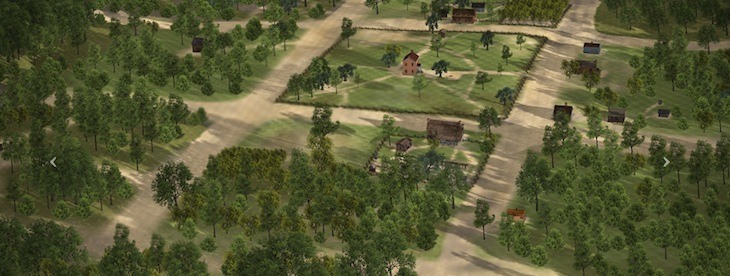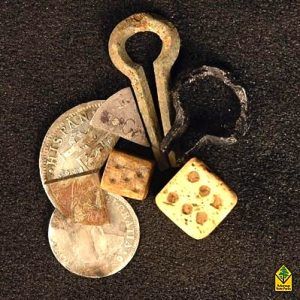Old Davidsonville dates back to ancient Arkansas, first state town to have a post office
by June 6, 2017 4:21 pm 1,988 views

Rendering of the town of Davidsonville in its early days.
Nobody knows when the first human settlements were made at Old Davidsonville near the Lawrence/Randolph County lines, but the 163-acre state park has a deep and rich history that spans thousands of years, said interpretive guide Ashley Hart.
She told Talk Business & Politics that about 95,000 visitors each year come to the park, located along Arkansas 166. It has a tourist information center, campground, lake, and other amenities that lure tourists from around the country, she said.
“It’s amazing the condition we found some artifacts in and what we’ve been able to do with them,” she said.
Native American Indians hunted and fished in the area long before the pyramids were erected in ancient Egypt. Remnants of those camps have been unearthed at the site. Pieces of wampum, a quantity of small cylindrical beads made from quahog shells and used as currency by Native Americans, have been found here. The Cherokee lived in the general area, as did other tribes, Hart said.
The Spanish explored this part of Arkansas in the late 1600s, according to historical accounts. It’s believed the Spanish had a fort or settlement close to Old Davidsonville at or near the modern-day town of Portia. A Spanish coin was plucked from the soil in the old town, and other artifacts that date before the Revolutionary War have been discovered, Hart said.
Old Davidsonville’s modern history began after the United States formed as a country. Settlers continuously migrated west, and in 1803 the U.S. bought a large swath of territory (Louisiana Purchase) from the French, and it included Arkansas. After a series of cataclysmic earthquakes along the New Madrid fault line in southern Missouri in 1811-12, settlers began to move into Arkansas. The Black River and other nearby rivers such as the Current and Spring, made the area ideal for trade and commerce.

Lawrence County, which would include all or parts of 30 counties in Arkansas and southern Missouri, was created Jan. 1, 1815, according to the Encyclopedia of Arkansas. Old Davidsonville was created as the county seat, and it became the first town in the Natural State to be surveyed. It was the first city to have a post office, beating Arkansas Post by one day, Hart said. The state’s first land office was also located in the town.
Within the next few years a courthouse, tavern, blacksmith shop, and other buildings were constructed. At its peak the town had about 200 people. Criminal and civil court were held in the town, and when a trial was about to begin, the town’s population would balloon to up to 600 people, Hart said.
“I guess that was a big deal back then,” she said.
In 1820, the town received perhaps its most famous visitor. Stephen Austin, known as “the father of Texas” spent two years as the circuit court judge in the first district, which included Old Davidsonville. Later, he would help colonize Texas with Americans and it ultimately led to its inclusion into the U.S.
Saucers, plates, wine bottles, bowls, pieces of eight, and many other relics have been unearthed by archeologists at the site. Through excavations, it has been determined where many of the buildings were located in the town, Hart said. Plans were underway to build a school and church, but things quickly changed in the fledgling town near the Black River on the edge of the Ozark Mountains.
Historians are not positive what exactly caused the town to die, but there are several factors, Hart said. An economic collapse in 1823 provided a significant financial blow to the community, and it was likely ravaged by constant floods along the river. A Yellow Fever epidemic may have also struck the region around this time, and there are rumors of a mass grave in or near the town, but those rumors have never been verified, she said.
In 1829 the county seat was moved, and when it did, the town’s fate was sealed. A ferry continued to operate for many decades afterwards at that spot, but the town vanished into the pages of history, Hart said.
